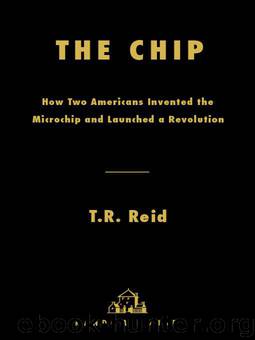The Chip: How Two Americans Invented the Microchip and Launched a Revolution by T. R. Reid

Author:T. R. Reid [Reid, T. R.]
Language: eng
Format: epub
Tags: Technology & Engineering, 20th Century, Corporate & Business History, Science, Semiconductors, Computers, Microelectronics, General, United States, Microelectronics - History, Kilby; Jack S, Electronics, Noyce; Robert N, Business & Economics, History
ISBN: 9780375758287
Google: idTXRE-w7G4C
Amazon: 0375758283
Publisher: Random House
Published: 1984-01-02T00:00:00+00:00
As fabrication plants turn out millions of chips that contain tens or hundreds of millions of transistors each, Moore—retired from active service at Intel, but still on the board—has spent some of his retirement time calculating just how many transistors are produced in a year. The comparisons he came up with demonstrate mainly how hard it is to imagine the numbers involved. At one point, Moore estimated that the number of transistors was greater than the number of raindrops that fall on California in an average year. Another calculation concluded that the semiconductor industry makes ten transistors per year for every ant on the earth.
With the steady decline in prices and the steep ascent in capacity since the birth of the microchip, the semiconductor industry has produced the greatest productivity gains in American industrial history. A graph comparing prices and capacity during the first forty years of the chip’s existence makes a nearly perfect X: the price curve angles sharply downward over time, and the capacity curve angles straight up. In the first generation of “solid circuits” back in the early 1950s, the chips were so simple and the prices so high that buyers were paying about $10 per transistor. By the year 2000, $10 would buy two 64-million-bit memory chips, with about half a million transistors. Clearly a 500,000-fold reduction in price is something special, and consequently it is probably unfair to compare the chip to other industrial products. The temptation is hard to resist, though, and the comparison is frequently made. In a typical version, Gordon Moore suggested what would have happened if the automobile industry had matched the semiconductor business for productivity. “We would cruise comfortably in our cars at 100,000 mph, getting 50,000 miles per gallon of gasoline,” Moore said. “We would find it cheaper to throw away our Rolls-Royce and replace it than to park it downtown for the evening. . . . We could pass it down through several generations without any requirement for repair.”
Another interested party who found this history hard to believe was Bob Noyce. “Progress has been astonishing, even to those of us who have been intimately engaged in the evolving technology,” he wrote.
An individual integrated circuit on a chip perhaps a quarter of an inch square now can embrace more electronic elements than the most complex piece of electronic equipment that could be built in 1950. Today’s microcomputer [on a chip], at a cost of $300, has more computing capacity than the first large electronic computer, ENIAC. It is 20 times faster, has a larger memory, is thousands of times more reliable, consumes the power of a light bulb rather than that of a locomotive, occupies 1⁄30,000 the volume and costs 1⁄10,000 as much. It is available by mail order or at your local hobby shop.
Noyce wrote that in 1977. Naturally, the passage is seriously out of date now. Today’s microcomputer on a chip is vastly more powerful than the model Noyce had in mind, and costs considerably less.
The dramatic increase in the capacity of a chip also improved circuit performance.
Download
This site does not store any files on its server. We only index and link to content provided by other sites. Please contact the content providers to delete copyright contents if any and email us, we'll remove relevant links or contents immediately.
| Circuits | Digital Design |
| Electric Machinery & Motors | Electronics |
| Fiber Optics | Networks |
| Superconductivity |
Whiskies Galore by Ian Buxton(41880)
Introduction to Aircraft Design (Cambridge Aerospace Series) by John P. Fielding(33064)
Small Unmanned Fixed-wing Aircraft Design by Andrew J. Keane Andras Sobester James P. Scanlan & András Sóbester & James P. Scanlan(32743)
Craft Beer for the Homebrewer by Michael Agnew(18141)
Turbulence by E. J. Noyes(7936)
The Complete Stick Figure Physics Tutorials by Allen Sarah(7307)
Kaplan MCAT General Chemistry Review by Kaplan(6867)
The Thirst by Nesbo Jo(6828)
Bad Blood by John Carreyrou(6552)
Modelling of Convective Heat and Mass Transfer in Rotating Flows by Igor V. Shevchuk(6391)
Learning SQL by Alan Beaulieu(6211)
Weapons of Math Destruction by Cathy O'Neil(6146)
Man-made Catastrophes and Risk Information Concealment by Dmitry Chernov & Didier Sornette(5921)
Digital Minimalism by Cal Newport;(5664)
Life 3.0: Being Human in the Age of Artificial Intelligence by Tegmark Max(5474)
iGen by Jean M. Twenge(5366)
Secrets of Antigravity Propulsion: Tesla, UFOs, and Classified Aerospace Technology by Ph.D. Paul A. Laviolette(5309)
Design of Trajectory Optimization Approach for Space Maneuver Vehicle Skip Entry Problems by Runqi Chai & Al Savvaris & Antonios Tsourdos & Senchun Chai(5011)
Pale Blue Dot by Carl Sagan(4912)
